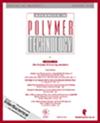分子量、密度和引发剂结构尺寸对PNIPAM聚合物刷与蛋白质之间排斥力影响的研究
IF 2
4区 工程技术
Q3 ENGINEERING, CHEMICAL
引用次数: 0
摘要
本文主要研究了聚合度(N)、密度(σ)和图案尺寸(x)对周期性图案聚N-异丙基丙烯酰胺(PNIPAM)刷与蛋白质之间相互作用力的影响。疏水相互作用、范德华引力和空间排斥力分别用N、σ和x表示。通过空间排斥力与实验得到的力距曲线的拟合,确定了渗透常数k1和熵常数k2。渗透常数为0.105,熵常数为0.255。利用这些常数,将立体排斥力绘制为底物与蛋白质之间分离距离的函数。在0.3 nm的分离距离处测定作用力,其中L0为PNIPAM刷的平衡厚度。在此分离距离下,大聚合度(N > 100)和密度(σ > 0.2链/nm2)下的空间排斥力远高于疏水相互作用和范德华引力之和。然而,对于小聚合度(N < 100)和密度(σ = 0.2),斥力相当于疏水相互作用和范德华引力的总和。此外,将空间排斥力绘制为图案尺寸x的函数。由图可知,当引发剂的结构尺寸小于200 nm时,在不同的聚合度和密度下,空间排斥力几乎为零。除了空间排斥力外,还通过低尺度计算了周期性图案PNIPAM刷中链的横向延伸,并与先前发表的文献的实验数据进行了比较。聚合物刷结构的建模就好像直接裸露的基板非常宽,即使拉伸的聚合物段也无法到达下一个聚合物刷结构。在这种模型中,横向延伸的值等于均匀刷的厚度。它与图案大小无关。然而,当聚合物刷结构建模时,如果在周期大小的一半距离处存在另一个聚合物刷结构,则发现由于链桥接导致的横向延伸取决于引发剂结构尺寸的大小。这可以通过使用PNIPAM刷的干涉图和空气和水中聚合物刷结构的原子力显微镜成像来证明。聚合物刷状结构在水中的分辨率远低于在空气中的分辨率,这表明聚合物链在水中有横向延伸。对于这种周期性聚合物刷结构,计算了它们之间的间隙,发现它与聚合程度、密度和引发剂结构尺寸有关。本文章由计算机程序翻译,如有差异,请以英文原文为准。
Investigation of the Effect of Molecular Weight, Density, and Initiator Structure Size on the Repulsive Force between a PNIPAM Polymer Brush and Protein
This paper focuses on the effect of degree of polymerization (N), density (
σ
), and pattern size (
x
) on the interaction force between a periodically patterned Poly(N-isopropylacrylamide) (PNIPAM) brush and protein. The hydrophobic interaction, the Van der Waals attractive force, and the steric repulsive force were expressed in terms of
N
,
σ
, and
x
. The osmotic constant (k1) and the entropic constant (k2) were determined from the fit of the steric repulsive force to an experimentally obtained force distance curve. The osmotic constant was 0.105, and the entropic constant was 0.255. Using these constants, the steric repulsive force was plotted as a function of the separation distance(s) between the substrate and the protein. The forces were determined at a separation distance equal to 0.3 nm, where L0 is the equilibrium thickness of the PNIPAM brush. At this separation distance, the value of the steric repulsive force was much higher than the value of the sum of the hydrophobic interaction and the Van der Waals attractive force for large degree of polymerization (
N
>
100
) and density (
σ
>
0.2
chains/nm2). However, the repulsive force was comparable to the sum of the hydrophobic interaction and the Van der Waals attractive force for a small degree of polymerization (
N
<
100
) and density (
σ
=
0.2
). Furthermore, the steric repulsive force was plotted as a function of pattern size
x
. The plot indicated that the steric repulsive force becomes nearly zero for all degrees of polymerization and density when the value of the initiator structure size was less than 200 nm. In addition to the steric repulsive force, the lateral extension of the chains in the periodically patterned PNIPAM brush was calculated by scaling low and compared with the experimental data taken from previously published literatures. The polymer brush structure was modelled as if the immediate bare substrate is so wide that even a stretched polymer segment cannot reach to the next polymer brush structure. In such models, the value of the lateral extension was equal to the thickness of the homogenous brush. It was independent of the pattern size. However, when the polymer brush structure was modelled as if there is another polymer brush structure at a distance half of the size of the period, the lateral extension was found to be dependent on the size of the initiator structure size due to chain bridging. This was witnessed by the patterning of polymer brushes using the interferometric patterning of PNIPAM brushes and an atomic force microscopy imaging of the polymer brush structures both in air and in water. The polymer brush structure resolution in water was much lower than the resolution in air, which indicates the lateral extension of the polymer chains in water. For such kind of periodic polymer brush structures, the gap between them was calculated, and it was found dependent on the degree of polymerization, density, and initiator structure size.
求助全文
通过发布文献求助,成功后即可免费获取论文全文。
去求助
来源期刊

Advances in Polymer Technology
工程技术-高分子科学
CiteScore
5.50
自引率
0.00%
发文量
70
审稿时长
9 months
期刊介绍:
Advances in Polymer Technology publishes articles reporting important developments in polymeric materials, their manufacture and processing, and polymer product design, as well as those considering the economic and environmental impacts of polymer technology. The journal primarily caters to researchers, technologists, engineers, consultants, and production personnel.
 求助内容:
求助内容: 应助结果提醒方式:
应助结果提醒方式:


